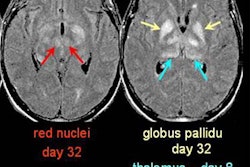CHICAGO - Researchers from Memorial Sloan-Kettering Cancer Center in New York City are reporting that proton magnetic resonance spectroscopy (MRS) can accurately predict Gleason scores in prostate cancer, making it the first effective, noninvasive method for staging prostate cancer.
Dr. Hedvig Hricak, chair of the department of radiology at MSK, discussed the new technology at a Wednesday press conference at the RSNA meeting. She is scheduled to present the study on Friday, December 6.
"Prostate cancer really requires ‘boutique’ treatment, tailored to each patient. This noninvasive diagnostic technology allows us to do that," she said.
The MRS technique analyzes choline, creatine and citrate. "When the Gleason score is 6, choline is slightly elevated and citrate is low, but present. When the Gleason score is 8, choline is dramatically elevated and citrate is no longer present," she said.
Hricak said that MRS will not replace biopsy, but it can be used in addition to biopsy. The technique could become more widespread in the clinical setting as commercial software packages begin to become available.
Hricak and colleagues were able to develop the "metabolic signature of aggressive prostate tumors" by correlating MRS images to Gleason scores using pathology specimens from 127 biopsy-proven prostate cancer patients.
All patients underwent endorectal MRI/MRS prior to radical prostatectomy with whole-mount, step-section pathology from November 1999 through December 2001. The MRS data were obtained on a 1.5-tesla Signa scanner (GE Medical Systems, Waukesha, WI) using software provided by the University of California, San Francisco.
MR imaging was followed by MRS with PRESS excitation and BASING water and lipid suppression, resulting in a 3-D spectral grid with 6.2-mm resolution. Prostatectomy specimens were whole-mounted and serially sectioned at 3-4 mm intervals. After paraffin embedding, micro sections were placed on slides and stained with hematoxylin and eosin. Cancer foci were outlined with colors corresponding to Gleason 3 or 4 cancers; Gleason 5 cancer was not differentiated from Gleason 4. Each prostate half was assigned a Gleason score (3+3, 3+4, 4+3, 4+4).
After elimination of patients who did not complete the exam or had poor signal-to-noise ratios or artifacts (n=16), patients with unavailable pathology slides (n=4), and patients with tumor only in the transition zone (n=4) or prostatitis (n=13), a population of 90 patients was used for analysis.
Of 180 prostate halves analyzed, 170 contained cancer. Overall, MRS detected cancer in 115/170 halves (68%). Of the 55 halves where MRS did not detect cancer, 48 (87%) were Gleason 3+3, 5 (9%) were Gleason 3+4, and 2 (4%) were Gleason 4+3. MRS detected all 11 Gleason 4+4 cancers.
An increase in MRS grade correlated positively with Gleason score (p < 0.001, Chi-square test). In addition, the presence of at least one suspicious voxel in which choline was the only detectable metabolite predicted a higher Gleason score (p < 0.0001, Fisher's exact test).
By Peggy Peck
AuntMinnie.com contributing writer
December 5, 2002
Copyright © 2002 AuntMinnie.com



.fFmgij6Hin.png?auto=compress%2Cformat&fit=crop&h=100&q=70&w=100)




.fFmgij6Hin.png?auto=compress%2Cformat&fit=crop&h=167&q=70&w=250)











